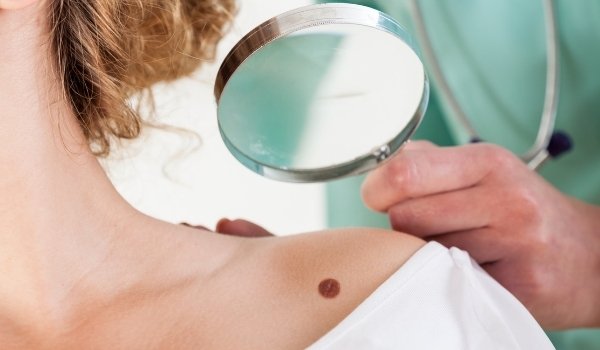While there are many different types of moles, moles in general are a common form of skin lesions that may seem worrisome in certain cases. For starters, let’s dive into an overview of moles, four common types of moles, when to see your dermatologist, and more.
What are Moles?
Moles are formed when skin cells grow in a cluster. These skin cells are called melanocytes, which give your skin color. The medical terminology for a mole is nevus, or nevi for moles. They are typically black or brown in color but can darken throughout your lifetime due to exposure to sun or pregnancy.
Moles can be flat or slightly raised. They can appear on any part of the body and can appear as a single mole or a cluster of them. Most adults have between 10-40 moles. While most appear before the age of 25, you can continue to grow moles throughout your life. Some of your moles may even fade away over time. What are the common types of moles to be aware of? Read on!
Four Different Types of Moles
There are 4 common types of moles: congenital moles, dysplastic nevi, acquired nevi, and spitz nevi. Below are the differences between each.
-
Congenital Moles
The first type of moles are congenital moles. This means that you were born with the mole(s). One in 100 people are born with moles, which means this is a very common occurrence. Congenital moles can be small or large. It’s important to know that congenital moles that are large increase your risk of melanoma forming.
-
Dysplastic Nevi
The second type of moles are dysplastic nevi. This is when a mole is considered abnormal. A mole is considered abnormal when it is larger in size, has uneven edges, or has an uneven surface. These moles can also be discolored or grow in size over time. This is one of the common types of moles that can transform into melanoma.
-
Acquired Nevi
The third type of moles are acquired nevi. These are moles that appear after you were born. This is not unusual and does not mean that this mole is cancerous. However, if you have 50 or more of these moles, then you may be at a higher risk for melanoma.
-
Spitz Nevi
Lastly, the fourth type of moles are spitz nevi. Spitz nevi can be hard to distinguish from melanoma unless your dermatologist performs a biopsy. These moles are often raised, pink, and dome shaped. You may notice different colors within the mole, such as red, black, and brown. It’s important to know that this type of mole may bleed or leak pus. You should speak to your dermatologist if you notice this happening.
Having moles does not mean you will get skin cancer. However, knowing how to tell when your moles may be a sign of skin cancer can help catch early signs of skin cancer. Awareness and taking action is an important step for prevention.
When Should I Make an Appointment with a Dermatologist?
Most types of moles are not a cause for concern; however, it is important to keep an eye on your moles so that you can know when it is time to see your dermatologist. A common way to identify if a mole may be melanoma is following the ABCDEs of moles. When doing a self-screening it is important to note the following:
A – Asymmetry: If your mole is not symmetrical, it may be a sign of cancer.
B – Borders: Jagged borders can be a sign of cancerous moles.
C – Color: Non-cancerous moles are usually a light or dark brown color. Cancerous moles are often multicolored.
D – Diameter: Benign moles are typically less than one millimeter in diameter. A mole that is larger can be a sign of melanoma.
E – Evolving: Benign moles typically do not change over time. If your mole changes size or color, make an appointment with your dermatologist.
It’s important to routinely check your moles for changes, but having a professional skin cancer screening completed yearly is the best way to notice early signs of melanoma. A dermatologist can help you keep an eye on moles that may be hard for you to see or those that may be at-risk for becoming cancerous.
How Do I Prevent Skin Cancer?
Routinely self-checking your moles is a great way to catch the early signs of melanoma, but how can you help prevent skin cancer? There are five ways to protect against skin cancer. We have already mentioned self-monitoring your moles, but what are the others? You have probably heard it before, but it bears repeating: wear your sunscreen! It is also important to refrain from using tanning beds, and covering your skin, no matter what the weather is like, is one of the most effective ways to prevent skin cancer. Don’t forget that UV rays can damage skin year-round, even if the sun is only peeking through the winter clouds.
Whether you are looking to schedule a routine screening of your moles, skin cancer screening, or skin cancer removal in Pittsburgh, Vujevich Dermatology Associates has you covered. Contact one of our offices today for any concerns, questions, or to schedule an appointment with one of our highly trained, board-certified providers.
Vujevich Dermatology Associates offers medical, surgical, cosmetic, and pediatric dermatology from some of the most highly trained physicians and clinicians in the greater Pittsburgh area. You can reach our team at 412-429-2570 or visit our contact page to see all of our locations. You can also follow us on Facebook to see what’s new in the world of dermatology.

